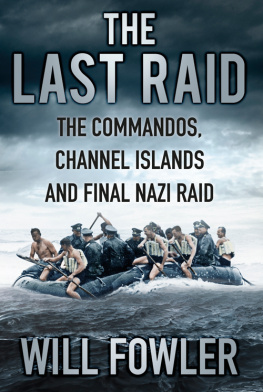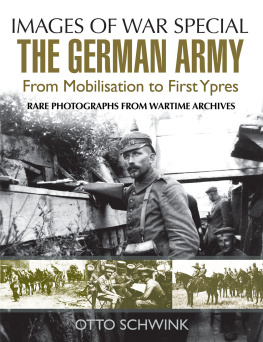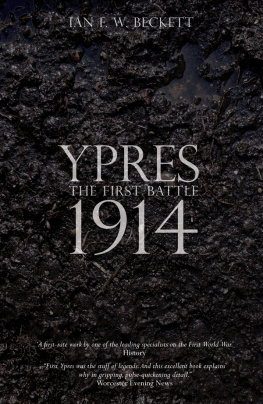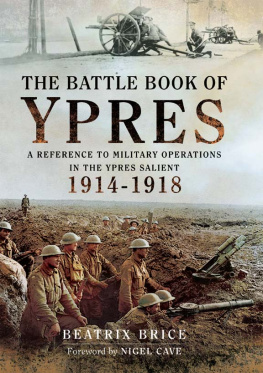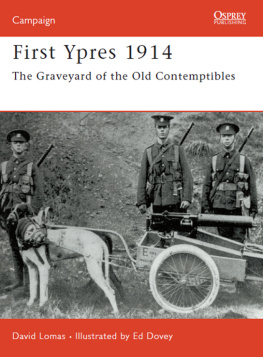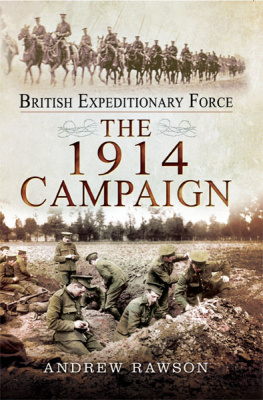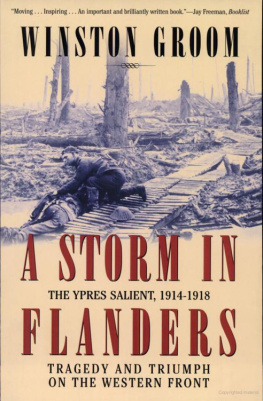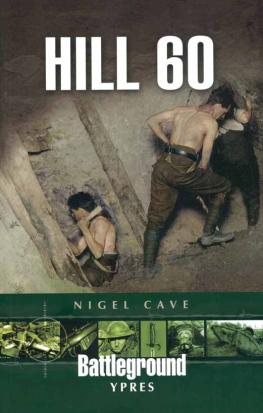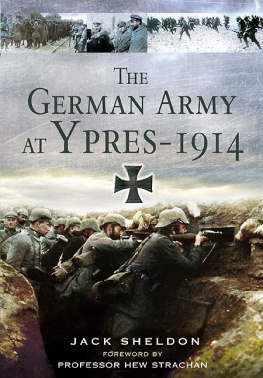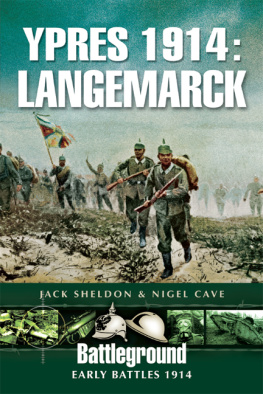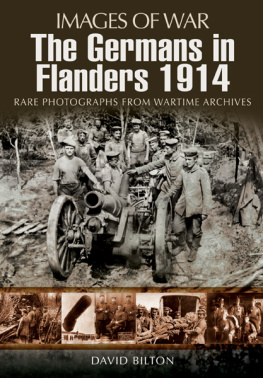
CONTENTS
The Commanders
The Soldiers
The Kit
The Tactics
First Ypres
Gheluvelt
The Wider Battle
The Langemarck Legend
Nonnebosschen
Relative Quiet
Second Ypres
Gravenstafel
St Julien
Frezenberg
Bellewaarde
The Salient
First Ypres
Second Ypres
All illustrations are from the Authors Collection, unless otherwise stated:
1The Menin Gate Memorial to the Missing.
2Winter sunlight picks out the concrete structure that was the dressing station at Essex Farm north of Ypres where Canadian doctor Lieutenant Colonel John McCrae composed the iconic poem In Flanders Fields.
3The shrapnel-pocked gate of the Cloth Hall at Ypres in 2011.
4The 1839 treaty, guaranteeing Belgiums neutrality.
5Lord Kitchener, the Secretary of State for War.
6German troops advancing along the road in 1914. (The Book of History The Worlds Greatest War, Vol. XIIII, The Grolier Society, New York, 1920; www.gwpda.org/photos)
7This card showing A street in Flanders was produced to raise funds for the British Committee of the French Red Cross to provide clothes, furniture, seeds, implements and childrens food for French refugees displaced by the war.
8Belgian and British troops fighting alongside each other in Ypres. (The War Illustrated Album DeLuxe, Vol. 1, Amalgamated Press, London, 1915, Courtesy of the Great War Photo Archive: www.gwpda.org.uk)
9In 1914 there was optimism and enthusiasm for war when men left for France. By the latter years, when the rush of volunteers had dried up and conscription had been introduced there was grim acceptance that the departure for the Western Front might be a one way trip.
10A sergeant with his load carrying equipment, rifle and bayonet stowed in the training manual positions.
11The British 18 pounder deployed during an exercise in Britain.
12At the outbreak of the First World War artillery was still seen as a close support direct fire weapon and so shrapnel and case shot would be used against infantry and cavalry.
13Erich von Falkenhayn.
14Field Marshal Sir John French watches troops who are going Up The Line.
15Preserved German trenches at Bayernwald; the use of hurdles to revet the trench walls was a typically German technique.
16A typical British soldiers equipment.
17The Short Magazine Lee Enfield in the capable hands of a Rifleman who is demonstrating the correct way in which to load a charger (clip) of five rounds.
18A British officer inspects a Lewis Light Machine Gun.
19A painting of Corporal Gibbons of the Royal Engineers constructing jam tin bombs in a frontline position.
20An observation balloon used for spotting the fall of shot for the Royal Artillery.
21A painting of Private Gudgeon of 1st Battalion, Northamptons who was awarded the DCM for his work as a runner and guide in the First Battle of Ypres.
22A postcard showing A British sentry in Flanders.
23The experience and professionalism of the BEF were demonstrated by Corporal Redpath of 1st Battalion Royal Highlanders (The Black Watch) who won the DCM during the First Battle of Ypres in November 1914.
24Field Marshal Douglas Haig who commanded I Corps at Ypres and would eventually command the BEF.
25The first man from the Indian sub-continent to be awarded the Victoria Cross, Sepoy Khudadad Khan.
26German prisoners carry a wounded British soldier.
27Cavalry troops patrol along the flooded Yperlee Canal, Ypres. (New York Times, 03/21/1915 Courtesy of the Great War Photo Archive: www.gwpda.org.uk)
28As the only survivor of his machine gun section Quartermaster Sergeant Downs of 1st Battalion, Cheshires manned a gun and beat off German attacks in November 1914 until reinforcements arrived. He was awarded the DCM.
29Lieutenant John Dimmer of the 2nd Battalion, Kings Royal Rifle Corps cleared jams in a machine gun on three occasions but suffered multiple wounds including a round that stuck him in the jaw during fighting on 12 November, 1914 at Klein Zillebeke. He was awarded the Victoria Cross.
30A cross, footballs and a Christmas tree mark one of the places where the Christmas Truce of 1914 broke out spontaneously.
31A modern sculpture of an Australian miner in Vierstraat, Wijtschate.
32Hill 60. This bunker constructed by the Australians is built on top of an existing German structure that had disappeared into the ground following mine blasts and shell fire.
33The savage fight in the south-east corner of Hill 60 on the night of 20 April 1915.
34Looking like strange rodents in their P Helmets or Tube Helmet gas masks, a ration party of the Kings Royal Rifle Corps is directed by 2nd Lieutenant Edward Allfrey to move through a gas saturated area.
35Later in the war canaries were used to detect poisonous gases. (Birds and the War, Skeffington & Son, London, 1919; www.gwpda.org/photos)
36Towering over the road junction at St Julien the statue of the Brooding Soldier is a powerful memorial to the heroic fight put up by Canadian troops of the CEF in the first gas attack of the war.
37The statue shows a soldier with arms reversed - the soldier has his head lowered and his hands resting on the butt of his rifle the drill position adopted by troops lining the route of a funeral.
38Rifleman F. Hamilton of 8th Rifle Brigade mans a Vickers machine gun during fighting near Hooge in July 1915.
3940-year-old Jemadar Mir Dast of the 55th Cokes Rifles (Frontier Force) would win the VC in fighting on 26 April 1915 in the Second Battle of Ypres.
40A British infantry shelter in Ploegsteert Wood in 2011.
41In an almost Napoleonic scene near Shell Trap Farm aka Mouse Trap Farm men of 1st Battalion, Royal Lancaster Regiment led by 2nd Lieutenant R.C. Leach launch a counterattack and capture a German flag on 24 May 1915.
42February 1918 the war has only nine more months to run as this weary stretcher party walks along a duckboard track in the pulverised terrain at Ypres.
43A grim but evocative name for a little Commonwealth War Graves cemetery near Ploegsteert Wood, a shell-shattered wood known as Plug Street to British soldiers.
44The caption to this card reads Scotties have a clean up after a spell in the trenches. The reality was that men stank, their clothing and bodies had lice, and it could be an effort to stay clean shaven, let alone clean.
45Pack mules loaded with shells are led off a corduroy road.
46A bunker integrated into the German trench system at Bayernwald.
47Photographed in 1917, Ypres has become a shell-shattered ghost town however the cellars still provided cover for troops transiting through the town. The Cloth Hall can be seen framed by the ruins in the foreground.
48An observer in a balloon took this picture of Ypres in 1917.
Front cover: A photograph of troops marching to Ypres, taken in 1917 by photographer Ernest Brooks, depite being taken later in the war this has become an iconic image of the entire Ypres campaign. (Crown Copyright)
At 8pm every day a simple ceremony takes place at the Menin Gate Memorial in the town of Ieper (Ypres) in Belgium. For a few moments before 8pm the noise of traffic ceases and stillness descends over the memorial. On the hour the regular buglers drawn from the local volunteer Fire Brigade step into the roadway under the memorial arch. They sound Last Post, followed by a short silence, followed by the Reveille. This ceremony has been carried on uninterrupted since 2 July 1928, except during the German occupation in the Second World War, when the tradition of the daily ceremony was kept alive at Brookwood Commonwealth War Graves Cemetery in Surrey, England. On the evening of 6 September 1944 as the Polish 1st Armoured Division was still fighting to clear parts of the town, men from the volunteer Fire Brigade took post at the Menin Gate and in a salute to liberation the ceremony was renewed.
Next page


